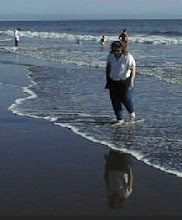60 - Size 6/0 White Beads
10 - Size 6/0 Orange with Red Stripe Beads
60 - Size 8/0 Transparent Green Beads
#12 Beading needle
White Nymo D Thread
2 - Gold colored Clamshell knot covers
1 - Gold colored Lobster Claw
1 - Gold colored Split Ring
527 brand or E6000 brand Adhesive
Wax or the thread conditioner of your choice
Chain nose Pliers

Before beginning, please note that this will make a very long (10 inch) anklet. Each set of daisy and stem equal about 1 inch, so you can shorten or lengthen it by adding or subtracting one set of daisy/stem for each inch.
1. Begin by threading your beading needle with about 4 feet of Nymo D thread. We will be working with a doubled thread, so this will be a bit easier to manage than it sounds. Stretch the thread well and pass it over the beeswax or other thread prep product.
2. Knot the end of the thread and place one of the clamshells on the needle, shell opening out, away from the needle. Place it over the knot and add a dab of glue. Close the clamshell with the chain nose pliers.
3. Add 4 transparent green beads to the thread, then add 1 transparent green dagger bead, and 2 more transparent green beads.
4. Add 4 white beads, and 1 orange/red stripe bead. Pass the thread through the first white bead closest to the last green bead strung, pointing the needle back in the direction from which it came. Pull snug.
5. Add 2 white beads to the thread, and pass the needle through the 4th white bead added in Step 4. This will be the bead closest to the red/orange bead.
6. Repeat from Step 3 until your chain reaches the length desired.
7. Add the other clamshell to the end of the thread, shell opening toward the needle.
8. Make a large knot very close to the clamshell, so that the thread holds tight and add a drop of 527 glue. Alternately, if you have trouble getting the knot close enough to the clamshell, cut the thread off of the needle, add a single size 11/0 bead to one of the threads, and tie several overhand knots around the Size 11/0 bead. Add glue to the knot and the Size 11/0 bead.
9. Close the clamshell with your chain nose pliers and trim the threads.
10. Add the lobster claw to one clamshell end, and the Split Ring to the other.
Enjoy your "New Leaf" Daisy Chain anklet. Try using yellow beads for the flower petals with a dark brown center bead, to make a sunflower. Or a dark purple center with light blue petals for a Morning Glory vine! Make them a bit shorter for wear as a bracelet! Pretty cute!











